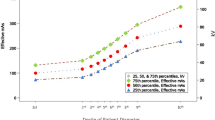Background and Purpose:
Permanent interstitial brachytherapy by seed implantation is a treatment alternative for low-volume low-risk prostate cancer and a complex interdisciplinary treatment with a learning curve. Dose-volume histograms are used to assess postimplant quality. The authors evaluated their learning curve based on dose-volume histograms and analyzed factors influencing implantation quality.
Patients and Methods:
Since 1999, 38 patients with a minimum follow-up of 6 months were treated at the authors’ institution with seed implantation using palladium-103 or iodine-125, initially using the preplan method and later real-time planning. Postimplant CT was performed after 4 weeks. The dose-volume indices D90, V100, V150, the Dmax of pre- and postplans, and the size and position of the volume receiving the prescribed dose (high-dose volume) of the postplans were evaluated. In six patients, postplan imaging both by CT and MRI was used and prostate volumes were compared with preimplant transrectal ultrasound volumes. The first five patients were treated under external supervision.
Results:
Patients were divided into three consecutive groups for analysis of the learning curve (group 1: n = 5 patients treated under external supervision; group 2: n = 13 patients; group 3: n = 20 patients). D90post for the three groups were 79.3%, 74.2%, and 99.9%, the V100post were 78.6%, 73.5%, and 88.2%, respectively. The relationship between high-dose volume and prostate volume showed a similar increase as the D90, while the relationship between high-dose volume lying outside the prostate and prostate volume remained constant. The ratio between prostate volumes from transrectal ultrasound and CT imaging decreased with increasing D90post, while the preplanning D90 and V100 remained constant. The different isotopes used, the method of planning, and the implanted activity per prostate volume did not influence results.
Conclusion:
A learning curve characterized by an increase in the D90post can be observed and results in a stable technique after 18 patients. An important factor influencing the learning curve in addition to the precision of seed positioning is organ volume definition on postimplant imaging.
Hintergrund und Ziel:
Die Qualität von Seed-Implantationen von Prostatakarzinomen steigt mit wachsender Erfahrung des behandelnden interdisziplinären Teams. Die Autoren nutzten Dosis-Volumen-Histogramme der Postpläne, um die Qualität der Behandlung im Zeitverlauf zu beurteilen und zu analysieren.
Patienten und Methodik:
Seit 1999 wurden am Universitätsklinikum Dresden 38 Patienten mit einer minimalen Beobachtungszeit von 6 Monaten mit Palladium-103- und Jod-125-Seeds therapiert. Die Planung erfolgte teils vor der Implantation, teils intraoperativ. Ausgewertet wurden die Dosis-Volumen-Kenngrößen D90, V100, V150 und Dmax der Prä- und Postpläne sowie die Größe und Lage des von der verschriebenen Dosis umfassten Volumens (Hochdosisvolumen) der Postpläne. Bei sechs Patienten wurden die Prostatavolumina sowohl im CT als auch im MRT bestimmt und mit dem durch transurethralen Ultraschall erhaltenen Volumen zum Zeitpunkt der Implantation verglichen. Die ersten fünf Patienten wurden unter externer Anleitung behandelt.
Ergebnisse:
Die Ergebnisse legten eine Einteilung der Patienten in drei Gruppen nahe: Gruppe 1—externe Anleitung (n = 5 Patienten); Gruppe 2—Lernphase (n = 13 Patienten); Gruppe 3—Routine (n = 20 Patienten), die sich in D90post (79,3%; 74,2%; 99,9%) und V100post (78,6%; 73,5%; 88,2%) unterschieden (s. Tabelle 1 und Abbildung 1). Das Verhältnis von Hochdosisvolumen zu Prostatavolumen zeigte einen ähnlichen Verlauf wie D90post, das Verhältnis des außerhalb der Prostata liegenden Hochdosisvolumens zum Prostatavolumen war im Zeitverlauf konstant (Abbildung 2). Das Verhältnis der Prostatavolumina aus CT und transurethralem Ultraschall sank bei steigender D90post (s. Abbildung 3). Bei den Präplänen waren sowohl bei D90 (124%) als auch bei V100 (98,4%) keine signifikanten Unterschiede zwischen den Gruppen zu erkennen. Das verwendete Isotop und die angewandte Planungsmethode hatten keinen Einfluss auf die Ergebnisse. Ebenso zeigte sich kein Einfluss der implantierten Aktivität pro Prostatavolumen (Abbildung 4).
Schlussfolgerung:
Die D90post zeigt im Zeitverlauf eine deutliche Lernkurve, die nach Patient 18 in eine stabile Phase übergeht. Eine wichtige Ursache ist neben der Präzision der Seed-Positionierung die Volumendefinition der Prostata in den Postplanbildern.
Similar content being viewed by others
Author information
Authors and Affiliations
Corresponding author
Rights and permissions
About this article
Cite this article
Hoinkis, C., Hakenberg, O.W., Lehmann, D. et al. Evaluation of Dose-Volume Histograms after Prostate Seed Implantation. Strahlenther Onkol 180, 550–556 (2004). https://doi.org/10.1007/s00066-004-1337-8
Received:
Accepted:
Issue Date:
DOI: https://doi.org/10.1007/s00066-004-1337-8




